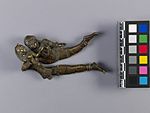Cutter
About this object
History of use
Betel cutters form part of the array of utensils and utilitarian objects used in the tambool chewing custom. The nut-cutters crack the areca nut to release the fruit, which is then wrapped in a betel leaf. Betel, paan or tambool chewing is a social custom prevalent throughout India. Traditionally, this custom represented the deity in religious ritual, was the symbol of auspicious beginnings, acted as the seal on alliances and even served as inspiration for verse, legends and paintings.
Cultural context
for cutting areca palm nuts
Physical description
Betel nut cutter depicting a bejewelled amorous couple, or mithuna. The male figure is holding a small, elaborately dressed and adorned female with his right arm. The female is offering the male a betel in her upturned palm. The male figure's legs form the cutter handles, and there is a blade on the right side of his body. The hinge is at the male figure's right shoulder. The male figure is decorated front and back, and the female figure is roughly finished on the back.
Categories
Materials
